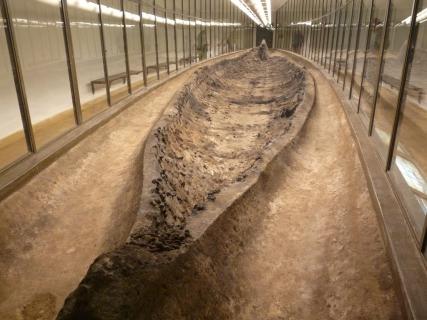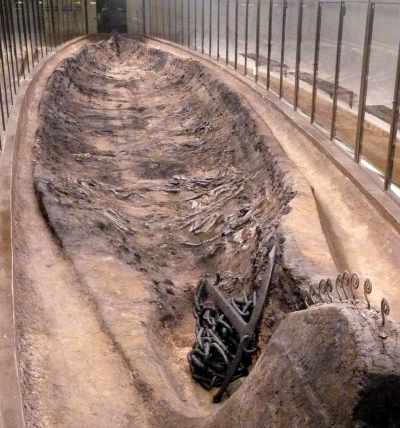The Ladby ship (22m long, 3m wide) is the only ship burial from the Viking Age discovered in Denmark. In 925, a Viking king was buried in this ship with 11 horses, 4 dogs and many grave goods. The ship has been preserved at the site where it was discovered, which today is part of a museum
![]()
Norse and Viking ramblings took me to Denmark earlier this week, specifically to north-east Fyn and the small but picturesque town of Kerteminde . Highlight of the trip for me was my first-ever visit to Vikingemuseet Ladby , home of Denmark’s only known ship-burial. This was discovered in the 1930s and excavated, as one sometimes did in those days, by the local amateur enthusiast, one Poul Helweg Mikkelsen, a chemist in Odense. But he did a splendid job and also had unusual foresight for those times to insist that the partially-excavated grave be left in situ in its mound. So there it is today (pictured left), you can still see the impression of the planks of wood and the many nails in their original position. You can also see the skeletal remains of eleven horses (their teeth are massive!) and probably four dogs. This custom of including horses and dogs in the burial is well-known and widely attested. We can speculate endlessly about the mindset that went in for this kind of mass slaughter to accompany one who was undoubtedly a wealthy and powerful local or regional chieftain. It’s also rather graphically illustrated in the reconstruction of the burial (pictured below) in the small museum on the site.

Both the horses and the ship were of course the expected accoutrements of a great chieftain like the one buried at Ladby. The burial mound is on the coast and, while he may not have lived at Ladby itself (the name means ‘loading settlement’), he certainly lived nearby and would have used both means of transport to get around. But there is more to this connection between ships and horses and we can get some insight into that by considering the poetry.

Much surviving Old Norse poetry, particularly in the skaldic genre, deals with ships, sailing and sea-battles, and the poets deploy a rich and surprisingly realistic vocabulary when dealing with such matters. But when it comes to the ships themselves, they also allowed themselves all kinds of flights of fancy, particularly in their use of kennings. As I touched on in a post last year , one of the most common kenning types is that which figures a ship as the ‘horse of the sea’. Oddly enough, the kenning does not work the other way round – in the whole of the skaldic corpus there is, I believe, only one example in which a horse is said to be the ‘ship of the land’ (parallel to the classic kenning-example of the camel as a ‘ship of the desert’), and that is a bit obscure. Nor is there that much realistic description of riding in the poetry. But the number and range of kennings which vary the ‘horse of the sea’ concept is quite astonishing and the examples below are just a selection.
The ‘horse’ can be a drasill, a fákr, a faxi, a hestr, a marr or a viggr, all of which are just different words for ‘horse’. Or it could be called by a typical horse-name, such as Blakkr ‘Dusky’, Hrafn ‘Raven’, Sóti ‘Sooty’ or Valr ‘Falcon’ (notice how the idea of substitution, so common to kennings, creeps into these horse-names, two of which are actually other animals, in fact birds). The ‘sea’, on the other hand, could be expressed through words that mean ‘wave’, such as bára, hrönn, unnr or vágr, or other words such as sundr ‘channel’, sær ‘sea’, or haf or lög ‘ocean’. Again, the idea of substitution can make things more complex, with the ‘sea’ being replaced by a sea-kenning such as eybaugr ‘island-ring’ or hvaljörð ‘whale-land’. You have to be pretty well-schooled in this way of thinking immediately to conjure up a picture of a ship when you hear of a ‘steed of the island-ring’ and kennings can often get even more complicated than that.
Not all ship-kennings involve horses, there are examples in which the base-words are bears, boars, elks, rams, reindeer and even swine. And just as horses sometimes had bird-names, so these kennings are reminiscent of the way in which ships were sometimes named after animals. Examples of such names from both the Viking Age and the medieval period include Ormr ‘Snake’, Trani ‘Crane’, Vísundr ‘Bison’, Hreinn ‘Reindeer’, Gammr ‘Vulture’, Elptr ‘Swan’ and Uxi ‘Ox’. There’s even a nice parallelism in the way that both horses and ships can be named after birds, though why anyone would have thought a vulture was a fine thing to name your ship after, we will never know.

Despite this maritime menagerie, the strongest association of the ship is still with the horse. Mastering a ship is rather a different skill from riding a horse, but the successful Viking Age chieftain, particularly in a landscape like that around Ladby, needed to be good at both. A ship was undoubtedly more expensive, and more difficult to replace, than a horse, so he would have had more of the latter. But both enabled him to cover more ground than the pedestrians he ruled over and, with one ship and several horses, he could also take a group of followers to support him in his endeavours. While almost anyone could have one horse, the chieftain had a lot of horses and at least one ship, perhaps precisely in the ratio of 11:1, as in the Ladby burial. This superiority in prestige of the ship over the horse may explain the kenning pattern mentioned above: while a ship could be figured as a horse, no horse could ever aspire to be a ship.
These associations are deep and complex, and fundamental to Viking Age concepts of leadership and masculinity. Much more could be said about them, perhaps drawing in those dogs that were also buried with the Ladby chieftain, and indeed his sword, another essential accoutrement of the well-accessorised Viking leader. And we mustn’t forget that women were also buried in ships, accompanied by horses, though
these associations are more difficult to untangle – was it only certain kinds of women and if so which kinds? The symbolism of both burials and poetry is endlessly fascinating and a real key to the Viking mind, if only we knew what it all really meant.
Related Post
A shocking documentary proves that mermaids do exist
SHOCKING Revelation: Thuya, Mother of Queen Tiye, Was the Grandmother of Akhenaten and Tutankhamun—What Ancient Egyptian Secrets Did She Leave Behind?
Breaking News: Astonishing Discoveries at Karahan Tepe Confirm an Extraterrestrial Civilization is Hiding on Earth, and NO ONE Knows!
Breaking News: Researchers FINALLY Discover U.S. Navy Flight 19 After 75 Years Lost in the Bermuda Triangle!
NASA’s Secret Investigation: Uncovering the Astonishing Mystery of the UFO Crash on the Mountain!
Explosive UFO Docs LEAKED: Startling Proof That Aliens Ruled Ancient Egypt!